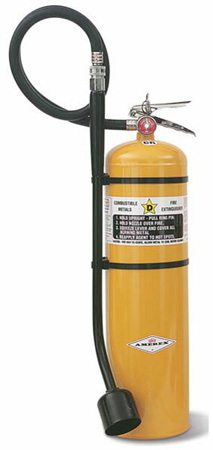



Find all of your laboratory and workplace safety supplies at Safety Emporium!
 Precautionary Statements |
 Glossary Index |
 RCRA |
| MSDS Topics |
Free Sites | FAQ's | Regulations | Glossary | Software | Suppliers |
| Books | Forum | Poll | Fun stuff | Quiz | Store | |
| Understand your MSDS with the MS-Demystifier | Search ALL our MSDS info | |||||
A pyrophoric material can spontaneously ignite in air. The word is derived from Greek for "fire-bearing".
Many pyrophoric materials are also water reactive, reacting vigorously with water or high humidity, often igniting upon contact.

Get your Class D and other specialty extinguishers from Safety Emporium.
Examples of pyrophoric materials include organometallic reagents such as alkyllithiums, alkylzincs, alkylmagnesiums (Grignards) and some finely divided metal powders. Specific examples include diborane (B2H6), diethylzinc (Zn(CH2CH3)2), tert-butyllithium (LiC(CH3)3) and diphosphine (P2H4).
These highly reactive substances are quite useful in the synthesis of organic chemicals, but special training is required to store and handle these materials safely. Most typically, pyrophoric materials are manipulated in an inert (unreactive) atmosphere of nitrogen or argon using specialized glassware.
Aldrich Chemical offers some technical data sheets which are useful for those working with pyrophoric materials. The following are in PDF format:
In addition, the American Chemical Society's, Division of Chemical Health and Safety (DCHAS) has made available a very useful paper Safe Handling of Organolithium Compounds in The Laboratory (Schwindeman, J. A., Woltermann, C. J., Letchford, R. J. J. Chem. Health & Safety 1992, 2, 6-11. doi:10.1016/S1074-9098(02)00295-2). This article discusses proper techniques as well as recent non-pyrophoric alternatives to traditional reagents such as n-butyllithium. In addition, those with questions can join the DCHAS Email Discussion List for comments and questions about pyrophoric materials or just any other matter concerning chemical health and safety.
Note that many laboratories use "quick and dirty" handling methods which pose a greater risk of laboratory accidents compared to the methods described in the Aldrich bulletins. For example, we've seen researchers fill a syringe with a pyrophoric liquid by inserting it into an unsecured, inverted septum-covered bottle. Such practices can have disastrous, if not fatal, consequences if the bottle is overpressurized, dropped, or broken, or if the bottle has a leaky septum or weak cap seal. Make sure the practices used in your workplace are approved by the manufacturer of the material you're using - don't just accept the word of a senior researcher whose technique may be sloppy.
Fires involving pyrophoric materials generally require a Class D fire extinguisher. Be sure you are properly equipped with a proper extinguisher before attempting to deal with a pyrophoric material. For example, using a carbon dioxide extinguisher on an alkylmagnesium fire would actually cause the fire to burn more intensely!
The Safety Data Sheet for a pyrophoric material will note this hazard under Section 2 (Hazard(s) identifications) as well as several other sections regarding firefighting measures, storage, stability and reactivity, transportation, and more. Always ready the complete SDS in detail for such substances.
Pyrophoric materials should only be used or handled by those with explicit training in their hazards, properties and use. If you can't fine an alternative to using a pyrophoric material (see the article cited in the previous section for alternatives, you must be properly trained and prepared.
Before working with pyrophoric materials, be sure to remove all unused equipment and flammable materials from the area (including waste containers) and ensure that a proper extinguisher is immediately available. Never work alone with a pyrophoric materials and always use proper personal protective equipment (PPE) such as safety goggles, face shields, safety shields, non-flammable lab coats and aprons. The use of Nomex® pilot's gloves is recommended for the handling of pyrophoric materials; these are manufactured by Sperian (Bacou Dalloz) and are sold commercially through several vendors. These are not fireproof, but are a good compromise between dexterity and (limited) flame resistance.
In addition, when using pyrophoric materials, know the location of the nearest safety shower(s) and emergency telephone. Such operations should be carried out in an inert atmosphere glove box or, at the very least, a fume hood whenever practical. Again, never work with pyrophoric materials alone.
Just to be sure we stress this enough, planning, preparation, and PPE are critical when using pyrophoric substances. In the fatal laboratory accident described below, an accident involving relatively small quantities of t-butyllithium caused the unfortunate and needless death of a UCLA researcher. The employee was not wearing all of the appropriate PPE and, after catching fire, she apparently ran away from the safety shower which was only six feet away. An official report on the incident is available through the California Department of Public Health's Fatality Assessment and Control Evaluation Program. It includes several recommendations for the handling of pyrophoric materials.
See also: combustible, flammable solid, water reactive.
Additional definitions from Google and OneLook.
Entry last updated: Sunday, January 8, 2023. This page is copyright 2000-2025 by ILPI. Unauthorized duplication or posting on other web sites is expressly prohibited. Send suggestions, comments, and new entry desires (include the URL if applicable) to us by email.
Disclaimer: The information contained herein is believed to be true and accurate, however ILPI makes no guarantees concerning the veracity of any statement. Use of any information on this page is at the reader's own risk. ILPI strongly encourages the reader to consult the appropriate local, state and federal agencies concerning the matters discussed herein.